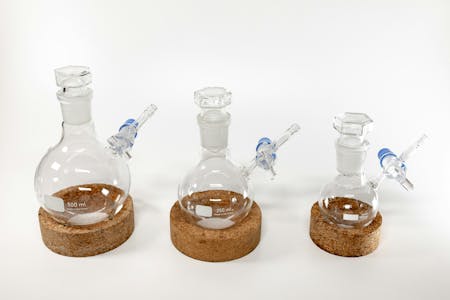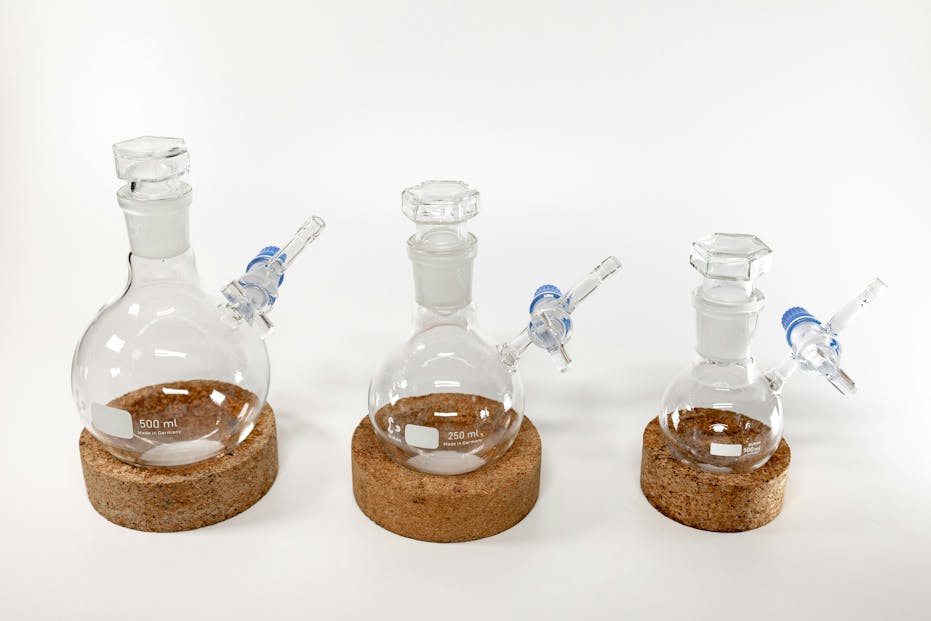What are Peroxides?
Peroxides are chemical compounds that occupy a special position in the world of chemistry. If you have ever heard about teeth whitening, disinfectants, or bleaches, you have probably come across the term "peroxides". They belong to a group of substances that we encounter more often in everyday life than one might think.



- But what exactly are peroxides?
- Hydrogen peroxide: The most well-known representative
- Organic and inorganic peroxides
- Hazards and Safety Precautions with Peroxides
- The Role of Catalase in Peroxide Decomposition
- Peroxides in Germany and the World
- By-products and Their Hazards
- Peroxides in Submarine Technology
- Contact Lenses and Peroxides
- Safety Measures When Handling Peroxides
- Peroxides in Teeth Whitening: An Overview
- Frequently Asked Questions (FAQs) about Peroxides
- Conclusion
But what exactly are peroxides?
Peroxides consist of a special bond between two oxygen atoms, which are either linked with other chemical elements or compounds. This oxygen-oxygen bond gives them special properties that are used in both industrial processes and daily life. Perhaps you have also heard of hydrogen peroxide (H₂O₂), one of the most well-known representatives of these chemical compounds. However, peroxides are much more diverse – they can form both organic and inorganic compounds, depending on which other atoms are bonded to the oxygen atoms.
Hydrogen peroxide: The most well-known representative
Hydrogen peroxide, also known as hydrogen peroxide, is one of the best-known peroxide compounds. It is an aqueous solution often used as a disinfectant or bleach. But why is that? Hydrogen peroxide is a strong oxidising agent. It can release oxygen, which makes it reactive and causes it to kill bacteria and viruses when used as a disinfectant.
Another area of application is the use of hydrogen peroxide as a bleaching agent. The oxygen released during decomposition destroys organic compounds such as dyes in teeth or hair, resulting in whitening. This property makes hydrogen peroxide a popular ingredient in conventional teeth whitening products. However, the use of peroxides, especially in high concentrations, can also have undesirable side effects, such as tooth sensitivity or irritation.
Organic and inorganic peroxides
In addition to the well-known hydrogen peroxide, there are numerous other peroxides that play an important role in chemistry and industry. These can basically be divided into two categories: organic and inorganic peroxides. Both have different properties and areas of application, but they have one thing in common: they contain the distinctive bond between two oxygen atoms, which makes them reactive and versatile.
Organic peroxides: The versatile catalysts
As the name suggests, organic peroxides contain carbon compounds in addition to the oxygen atoms. These organic compounds are of great importance in chemistry as they are used as catalysts in various industrial processes, especially in polymerisation. In polymerisations, small molecules (monomers) are linked to form large molecular chains (polymers) – a process that is often involved in the production of plastics. Organic peroxides play an important role here, as they initiate the necessary chemical reactions that start the polymerisation process.
A well-known example of the use of organic peroxides is the anthraquinone process. In this industrial process, hydrogen peroxide is obtained by reducing anthraquinone. This hydrogen peroxide solution is then used in various fields, including the pulp and paper industry, to bleach paper.
However, organic peroxides can also be dangerous as they are considered explosives in some cases. Particularly at high concentrations and in unstable mixtures, they can react violently under certain conditions. Therefore, organic peroxides are strictly monitored, and safety regulations for their storage and handling apply.
Peroxides and Polymerization
Peroxides play an important role in the polymerization of plastics. Organic peroxides are often used as initiators to start chemical reactions that lead to the production of plastics. These reactions are often highly exothermic, meaning they release a lot of heat, which allows for the production of large quantities of plastic. Polymerization is a process in which small organic compounds (monomers) are linked into large molecular chains (polymers), making peroxides indispensable catalysts.
Inorganic Peroxides: Highly Reactive and Versatile
Unlike organic peroxides, inorganic peroxides do not contain carbon compounds. A well-known example of an inorganic peroxide is sodium peroxide (Na₂O₂), which is often used as a strong oxidizing agent in the pulp industry. Here it is used as a bleaching agent to whiten pulp. Sodium peroxide helps to remove discolourations by undergoing chemical reactions with the organic compounds in the pulp.
Inorganic peroxides are often characterised by their high reactivity. They react quickly at higher temperatures, releasing large amounts of energy. This property makes them particularly useful in areas such as rocket propulsion technology, where they are used as oxidizers to generate large amounts of energy. An example of this is the use of liquid oxygen and inorganic peroxides in special chemical processes that take place under extreme conditions.
Hazards and Safety Precautions with Peroxides
Both organic and inorganic peroxides can become dangerous under certain conditions, especially when they come into contact with other chemicals or high temperatures. In such cases, they can form reactive mixtures that may develop explosive properties. Particularly hazardous are hydroperoxides, a special group of organic peroxides that are often very unstable and therefore particularly reactive. Such hydroperoxides can be easily decomposed in connection with atmospheric oxygen, potentially triggering dangerous reactions.
Another example is peroxides, which in chemistry represent a distinct group of substances. Peroxides can occur in both industrial processes and nature; they are often reactive and can easily decay, particularly in connection with high temperatures or other reactants.
The Role of Catalase in Peroxide Decomposition
Hydrogen peroxide also occurs naturally in the human body, albeit in very low concentrations. However, in higher concentrations, it is harmful. Therefore, the body has developed mechanisms to break down hydrogen peroxide. An enzyme called catalase plays a central role in this process. Catalase breaks down hydrogen peroxide into water and oxygen, rendering the substance harmless to the body. These chemical reactions occur quickly, preventing hydrogen peroxide from causing damage in the body.
Peroxides in Germany and the World
In Germany, peroxides are used in many industrial sectors, whether in the chemical industry, medicine, or food processing. Hydrogen peroxide is used, for example, as a disinfectant in hospitals or as a bleaching agent in the paper industry. However, peroxides also have their hazards. In high concentrations and under certain conditions, peroxides can form reactive, even explosive, compounds. Therefore, there are strict safety measures in the industry for handling these chemicals.
Special precautions are also necessary for the storage and transport of peroxides. Due to their reactivity and explosiveness, peroxides must be stored safely and under special conditions to prevent accidents. In Germany, there are strict regulations for handling such hazardous substances.
By-products and Their Hazards
The use of peroxides often results in by-products that can also be reactive or dangerous. For example, when hydrogen peroxide decomposes, oxygen can be released, which in large quantities can lead to dangerous pressure increases. The peroxide ions produced during the decomposition are also problematic in high concentrations as they exhibit explosive properties.
Therefore, it is important that you always observe safety measures when coming into contact with peroxides. Wear gloves and safety glasses, avoid skin contact, and ensure that peroxides do not come near sources of ignition.
Peroxides in Submarine Technology
Did you know that peroxides are even used in submarine technology? In some submarines, hydrogen peroxide serves as a source of oxygen because it can release oxygen underwater. This oxygen is then used by the submarines for breathing or energy production. Once again, this demonstrates how versatile and important peroxides are in our daily lives and in industry.
Contact Lenses and Peroxides
Another everyday application of hydrogen peroxide is the cleaning of contact lenses. Many cleaning solutions for contact lenses contain hydrogen peroxide because it effectively removes bacteria and other contaminants from the lenses. However, the hydrogen peroxide must be completely neutralised after cleaning before the contact lenses can be reinserted, as it can otherwise cause eye irritation.
Safety Measures When Handling Peroxides
Because peroxides are very reactive and potentially dangerous substances, it is important to always observe the necessary safety measures when handling them. Especially in high concentrations, they can be explosive or trigger dangerous chemical reactions in combination with other substances. Peroxides should be stored in a cool and dry place, and care should always be taken to ensure that they do not come into contact with flammable materials.
Peroxides in Teeth Whitening: An Overview
Teeth whitening is a widespread desire of many people striving for a radiant smile. Over time, teeth can become discoloured due to the consumption of foods such as coffee, tea, red wine, or smoking. Many conventional teeth whitening products rely on peroxides, particularly hydrogen peroxide, to remove these discolourations. But what exactly happens when peroxides are used in teeth whitening? And what risks are associated with this method?
How hydrogen peroxide works in teeth whitening.
Hydrogen peroxide is a strong oxidizing agent that is commonly used in tooth whitening products. When hydrogen peroxide is applied to the surface of teeth, a chemical reaction begins in which oxygen is released. This oxygen penetrates the enamel and breaks down organic compounds that cause discolouration. The result is a visibly brighter tooth surface.
In many whitening products used both at home and in dental practices, hydrogen peroxide plays a central role. Dental practices often use higher concentrations of this active ingredient to achieve quick and visible whitening. Such treatments, like the so-called in-office bleaching, require careful application to avoid damage to the teeth or gums.
Long-term effects of peroxides on dental health
Although hydrogen peroxide is an effective method for whitening teeth, there are increasing concerns about its potential long-term effects on dental health. One of the most common problems that can arise from the use of hydrogen peroxide is increased tooth sensitivity. Since the peroxide penetrates deeply into the enamel, it can also reach the underlying dentin. This can lead to temporary or in some cases even permanent sensitivity.
There is also the risk of gum irritation, particularly when peroxide is used in high concentrations. In some cases, it can even cause burns to the gums. Another problem is the potential weakening of the enamel with repeated use. Frequent use of peroxides can thin the enamel, making the teeth more susceptible to cavities and other damage.
ALPINE WHITE: A gentle revolution in tooth whitening
Our philosophy at ALPINE WHITE is based on the belief that you can have a radiant white smile without compromising your dental health. We know that many people have concerns when it comes to tooth whitening, especially due to the risks associated with the use of hydrogen peroxide. That is why we have developed products that naturally whiten your teeth while also being gentle on your dental health.
Our in-office treatments are not only gentle but also effective. We have worked intensively on formulas that deliver results without resorting to aggressive chemicals. So you can be confident that your teeth will remain healthy and strong even after treatment.


Gently achieve whiter teeth with our pain-free in-office bleaching. Carried out by our specialised dental staff.
- Naturally white teeth
- Effective tooth whitening without peroxides
- No change in the tooth structure
Frequently Asked Questions (FAQs) about Peroxides
What is hydrogen peroxide?
Hydrogen peroxide is a chemical compound made up of hydrogen and oxygen (H₂O₂) that is often used as a disinfectant and bleaching agent.
Are peroxides dangerous?
In high concentrations, peroxides can be very reactive and even explosive. Therefore, they should always be handled and stored with care.
How does hydrogen peroxide work in tooth whitening?
Hydrogen peroxide destroys colour pigments through a chemical reaction in which oxygen is released, resulting in tooth whitening.
Are ALPINE WHITE products peroxide-free?
Yes, ALPINE WHITE offers tooth whitening products and in-office bleaching without peroxides to enable gentle and mild whitening.
Conclusion
Peroxides, whether organic or inorganic, are fascinating chemical compounds that play an important role in many areas of our lives. Whether in tooth whitening, the pulp industry, polymerisation or even in rocket propulsion technology – peroxides are indispensable. At the same time, their high reactivity and potential explosiveness require special precautions.
At ALPINE WHITE, we have consciously decided against the use of peroxides in our tooth whitening products in order to provide our customers with a gentle yet effective way of tooth whitening. We believe that your oral health should come first, and that is why we rely on safe and innovative solutions that do not involve the risks of conventional peroxides.


